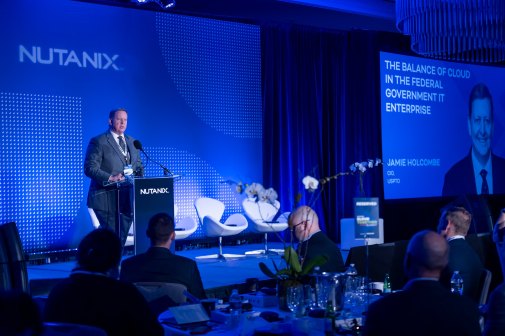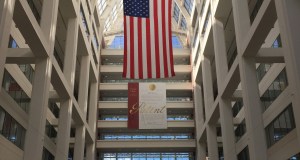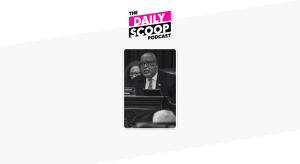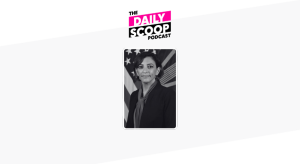The U.S. Patent and Trademark Office has been celebrated both in and out of government for its decade-plus of teleworking practices. But revelations this week that some teleworking patent examiners appear to be gaming the system and that supervisors lack the tools to deal with the misconduct have reopened long standing concerns about teleworking practices in the government workplace.
Todd Zinser, inspector general for the Commerce Department, requested in September 2012 that USPTO perform an administrative inquiry into a series of complaints he received claiming patent examiners were falsely reporting their time worked and attendance, among other things. The 16-page report he received, which was since publicized by the Washington Post, said “the investigation team was not able to reach a conclusion on whether some Patent Examiners are accurately reporting [time and attendance] or whether the Agency has effective controls to guard against [it].”
Though true, that was only part of the story. The report Zinser’s office received last summer was actually a polished version of a 32-page report USPTO originally produced before cutting it in half and dropping many supporting details. USPTO would later say the initial document was an unofficial rough draft of sorts.
The initial report said “the interviewers found that many supervisors had troubling answers to some of the questions that were asked” and claimed that the allegations of telework time and attendance reporting abuse was unsubstantiated only because there were not proper tools in place to manifest physical evidence of such. When supplemented with anecdotal evidence in the first draft, however, it seemed a more condemning story, including reports that the directors in charge allegedly looked the other way.
Listing multiple examples, the report explains how supervisors had beliefs or even evidence that patent examiners were committing time fraud in a period between June 21 and Aug. 29, 2012, claiming wages for hours not actually spent working. When they went to pull computer records to prove the misconduct, many supervisors, who “are provided with very few tools” to begin with, were met with refusal from their assistant deputy commissioners.
One examiner who had been teleworking with the option to “hotel” at the physical office was suspected of submitting incomplete work for credit to meet deadline, what USPTO calls mortgaging. Corresponding with that mortgaging, the supervisor found 265.5 hours for which there was no evidence she was working and $12,533.02 in pay for those fraudulently claimed hours.
“When the [team of directors] was notified of the time fraud, they asked the [assistant deputy commissioner] if they could use the computer records as evidence so she could be charged with misrepresenting her timesheet,” the initial report states. “The ADC refused to allow the [directors] to use the computer records as evidence; as such, the examiner was not charged with time fraud. The examiner was, instead, charged with not following the hoteling policy for her lack of responsiveness to her supervisor’s repeated attempts to get in touch with her and failure to follow supervisory instructions.”
And why don’t the ADCs give up the records?
“The reason given for not allowing use of the records was not wanting to create a ‘big brother’ atmosphere,” the report says. “However, this results in a frustrated management team that cannot effectively deal with serious misconduct and feels they are in effect being told to look the other way. This tends to actually have a negative effect on the vast majority of employees who work hard and are diligent about their time and see misconduct being tolerated.”
The initial report goes into detail on other ways examiners were abusing the system, like saving the bulk of work for the end of a quarter, formally known as end loading, which investigators were able actually prove with statistical evidence. They found that 20 percent of examiners — 1,600 of them — did 50 percent or more of their work in the last four weeks of a quarter, meaning they probably weren’t spending too much time in the weeks before on work. Supervisors expressed that they didn’t have the proper tools in place to monitor this misconduct and that they saw it as a detriment to the quality of work produced.
There’s obviously many issues at play in the initial report: a lack of tools to manage misconduct, upper-leadership refusing to comply and the potential that the office tried to obscure the report in some way by giving the IG a document that was half the size of its original draft.
Regarding the first two issues, the report claims that “in recent years, more and more of the existing controls have been used as bargaining chips with the union to reach agreements on Agency initiatives. This has resulted in a lackadaisical approach to enforcing work schedules and telework programs, as well as a failure to address end loading and other performance-manipulation issues.”
And as for the two versions of the report, USPTO Chief Communications Officer Todd Elmer recently attempted to quell any suspicion of a coverup saying the initial report was a rough draft of the final one turned into Zinser:
“The February 2013 rough draft of the report was an initial attempt to describe the full investigation record,” Elmer said. “As part of standard protocol, the USPTO’s Office of the General Counsel and the Office of the Chief Administrative Officer jointly reviewed the draft document and concluded that it was incomplete, inaccurate, and that it reflected only a partial characterization of the entirety of the full record. Additionally, both the Office of the General Counsel and the Office of the Chief Administrative Officer considered many of the conclusions reached in the draft report to be partial and unsupported by the facts and record of the investigation and thus counseled that the final, signed, draft of the report contain a more accurate, complete reflection of the entirety of the investigation’s record of interviews and supporting data, which it ultimately did.”
Elmer said the summaries of supervisor interviews were added as supporting documents but not integrated into the body of the final draft. According to Elemer, the IG “found the USPTO’s report and supporting record to be sufficient.”
However, in April Commerce’s Office of the Inspector General announced an audit of USPTO’s quality assurance processes in wake of the internal reports. Despite the belief expressed in the report that “loosened controls has either encouraged, or at the very least, failed to discourage” misconduct with potential implications throughout the agency, USPTO Deputy Director Michelle Lee at a Patent Public Advisory Committee meeting called them “isolated problems in our telework and timekeeping systems” and said “the evidence did not support a finding of widespread or systemic abuses.”
And since the reports were published, Lee reassured the committee, USPTO has implemented several new systems to correct the issues addressed, such as new guidance for tracking work, a new educational campaign for telework policies and a new working group to investigate patent examination counting and the possible implications of end loading.






